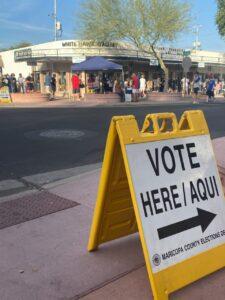The year was 2004. The City Council consisted of Mayor Mary Manross and Councilmembers Wayne Ecton, Bob Littlefield, Cynthia Lukas, Ned O-Hearn, Roberta Pilcher, Tom Silverman and then Councilmember David Ortega.
That March, Scottsdale voters were asked to consider a major change to the way its City Council would be elected. Instead of 6 councilmembers being voted in by a city-wide majority Proposition 100 offered a change to six new council districts, which in turn would elect its own representative to council.
The argument then, as we hear some making now, is that Scottsdale has become so large that it should follow the lead of Phoenix, Mesa, Glendale and others.
 But Proposition 100 was soundly defeated in 2004. With 61% voting no and only 39% yes.
But Proposition 100 was soundly defeated in 2004. With 61% voting no and only 39% yes.
A look back at the hows and whys is noteworthy and instructive. Scottsdale voters south of Camelback were positive on districts while those north of it were overwhelmingly opposed.
The pro-district forces didn’t raise much money and were largely made up of what might be described as a pro-development campaign. Its largest donor was landowner Henry Becker, he of weird protest signs at Pima and Happy Valley Road infamy. The 6-district construct offered to the electorate was the result of a task force.
The opposition didn’t raise much money either. Its leadership reads like a who’s who of anti-growth activists over the years. John Washington. Don Badenoch. Lee Tannenbaum. Susan Wheeler. Sam West. Patty Badenoch. Lois Fitch. The powerful Coalition of Pinnacle Peak led donations to the “Don’t Lose Your Vote” opposition campaign.
The arguments then, as might be heard again soon if Mayor David Ortega makes progress on his campaign pledge to offer another district proposal to voters in 2022, largely went like this:
In Support . . .
- Fair representation to the diverse areas of the city, not just from one region of Scottsdale
- Lesser amount of money spent on elections (district v. city-wide)
- Develop healthy economic development and business-friendly climate
- Accountability on council
- Join other cities that have a positive track record using districting in elections
- Increase participation in local elections
In Opposition . . .
- Create more division and fraction within the city
- Be more pro-development and encourage special interest money
- Less choice in candidates and less representation
- Costs to taxpayers too high to pay for: district line drawing, census, Ballots
- Neglect city-wide issues that affect all citizens (downtown, WestWorld, Preserve, Airport)
- Poor ballot language and too vague to provide restrictions/timeline
Recognizing that Scottsdale voters had spoken on the traditional district system proposed twelve years prior Scottsdale Mayor Jim Lane offered a “hybrid-district” system in 2016. It preserved at-large elections for three councilmembers and Mayor but suggested creating a North, Central and South District. He suggested it might be the best of all worlds and in keeping with the uniquely Scottsdale way of doing things. The measure was polled by Lane and enjoyed widespread appeal. But his fellow councilmembers did not join him in sufficient numbers so no public vote on his proposal materialized.
Fast forward to the 2020 elections where Mayor David Ortega suggested another variation. His idea would largely retreat to the pure district model but create two representatives from each of three new districts, presumably consisting of North, Central and South.
Ortega is now making it known he intends to push this idea forward. But it is unclear if one of the largest systemic changes in Scottsdale history has a majority to put in on the ballot. Besides the policy ramifications, most of the council lives in the north so members might be putting themselves out of a position by voting to move the idea forward. That’s a tough sell.
There are rumblings too that he may try to go around the council and pursue an initiative. But where such necessary, significant funding would come from is unknown. Historic giving to district reform matters, as described for 2004, is not encouraging.
While Scottsdale’s General Plan possibilities are already creating interesting debate, the effort to reform the essence of Scottsdale governance maybe even more so in the coming months.
Scottsdale is a pretty special place. Districts were never a part of its beginnings and evolution. Maybe that’s why it has developed differently and better than most if not all in Arizona.
Or perhaps it is time for a large growing city to change just like Phoenix, Mesa and Glendale did. Or is it better to stay with the likes of Tempe, Chandler, Gilbert and Paradise Valley? All are doing well and have resisted district temptation.
Time will tell. But if past is prologue rancorous the discussion will likely be, with the prospect of a change very much in doubt.

